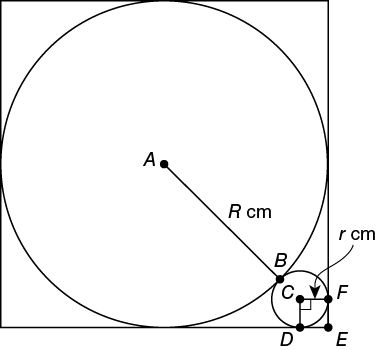题目信息

The figure above shows 2 circles. The larger circle has center A, radius R cm, and is inscribed in a square. The smaller circle has center C, radius r cm, and is tangent to the larger circle at point B and to the square at points D and F. If points A, B, C, and E are collinear, which of the following is equal to
 ?
?
A:

B:

C:

D:

E:

参考答案及共享解析

共享解析来源为网络权威资源、GMAT高分考生等; 如有疑问,欢迎在评论区提问与讨论
本题耗时:
已选答案:
正确答案:
D:

Geometry Circles; Pythagorean theorem
Because is a diagonal of square CDEF, which has side length r, it follows from the Pythagorean theorem that r2 + r2 = (CE)2, and hence CE =
is a diagonal of square CDEF, which has side length r, it follows from the Pythagorean theorem that r2 + r2 = (CE)2, and hence CE =  .
.
Tip A sometimes useful shortcut is the fact that, for a square we have d = , where d is the diagonal length and s is the side length. This can be obtained by applying the Pythagorean theorem as above or by using properties of a 45–45–90 triangle.
, where d is the diagonal length and s is the side length. This can be obtained by applying the Pythagorean theorem as above or by using properties of a 45–45–90 triangle.
Therefore, BE = r + = r(1 +
= r(1 +  ) and AE = R + r(1 +
) and AE = R + r(1 +  ). Since 2(AE) is the diagonal length of the large square, which has side length 2R, it follows from the above tip that 2(AE) = (2R)
). Since 2(AE) is the diagonal length of the large square, which has side length 2R, it follows from the above tip that 2(AE) = (2R) , or AE = R
, or AE = R . Alternatively, an appropriate application of the Pythagorean theorem gives R2 + R2 = (AE)2, or AE = R
. Alternatively, an appropriate application of the Pythagorean theorem gives R2 + R2 = (AE)2, or AE = R . Now substitute for AE and solve for
. Now substitute for AE and solve for  .
.

From the last equation we get .
.
The correct answer is D.
Because
 is a diagonal of square CDEF, which has side length r, it follows from the Pythagorean theorem that r2 + r2 = (CE)2, and hence CE =
is a diagonal of square CDEF, which has side length r, it follows from the Pythagorean theorem that r2 + r2 = (CE)2, and hence CE =  .
.Tip A sometimes useful shortcut is the fact that, for a square we have d =
 , where d is the diagonal length and s is the side length. This can be obtained by applying the Pythagorean theorem as above or by using properties of a 45–45–90 triangle.
, where d is the diagonal length and s is the side length. This can be obtained by applying the Pythagorean theorem as above or by using properties of a 45–45–90 triangle.Therefore, BE = r +
 = r(1 +
= r(1 +  ) and AE = R + r(1 +
) and AE = R + r(1 +  ). Since 2(AE) is the diagonal length of the large square, which has side length 2R, it follows from the above tip that 2(AE) = (2R)
). Since 2(AE) is the diagonal length of the large square, which has side length 2R, it follows from the above tip that 2(AE) = (2R) , or AE = R
, or AE = R . Alternatively, an appropriate application of the Pythagorean theorem gives R2 + R2 = (AE)2, or AE = R
. Alternatively, an appropriate application of the Pythagorean theorem gives R2 + R2 = (AE)2, or AE = R . Now substitute for AE and solve for
. Now substitute for AE and solve for  .
.
From the last equation we get
 .
.The correct answer is D.
 加入收藏
加入收藏
 在线答疑
在线答疑
题目来源



























